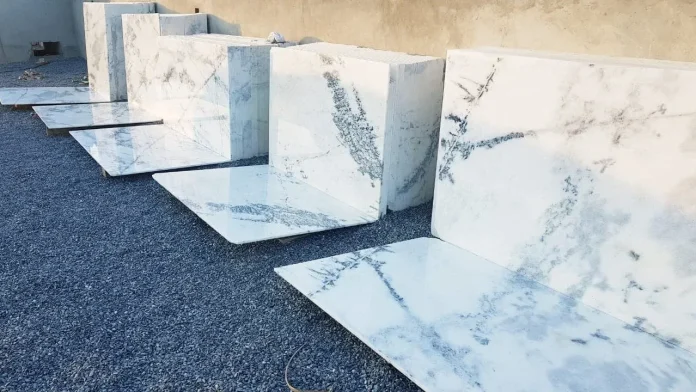Amba Ji White Marble, a gleaming white natural stone quarried near the sacred town of Ambaji in Gujarat, is one of India’s most revered marbles. Known for its spiritual significance, crystal-clear appearance, and long-lasting durability, this marble has become a staple material in religious, residential, and architectural constructions across the globe.
In This Article:
What makes Amba Ji White Marble exceptional is not just its physical beauty but also its deep-rooted connection with Indian tradition and culture. Its origins trace back to one of the holiest sites in the country, and it has earned global recognition for its exceptional purity and quality.
Origin and Historical Significance
The Birthplace — Ambaji, Gujarat
Located in the Banaskantha district of Gujarat, Ambaji is home to the famous Ambaji Temple, one of the 51 Shakti Peethas in India. This holy town sits on the edge of the Aravalli Range, which is rich in high-quality natural stone deposits.
Amba Ji White Marble is extracted from the nearby Arasuri Hills, where the marble beds run deep and are known for producing clean, uniform white stones with minimal veins. The region has been a hub for marble quarrying for centuries, and today, it remains one of the most sought-after sources of white marble in the world.
Physical Characteristics of Amba Ji White Marble
Amba Ji White Marble is appreciated for its creamy white base, consistent color tone, and subtle natural veins that make each slab unique yet elegant. Here are its key physical properties:
Key Features
- Color: Milky white to ivory, with minimal veining
- Texture: Fine-grained with smooth surface
- Finish Types: Polished, honed, sandblasted, and matte
- Thickness Options: 16mm, 18mm, 20mm, and customized
- Porosity: Low, enhancing its resistance to moisture and stains
- Hardness: Excellent compressive strength, suitable for heavy use
- Maintenance: Easy to clean and maintain, ideal for long-term use
This marble holds polish extremely well, maintaining its gloss and smoothness over decades.
Uses and Applications
Amba Ji White Marble is extremely versatile and is used in a wide range of structures—from ancient temples to ultra-modern villas. Its aesthetic appeal and strength make it suitable for both interior and exterior applications.
Religious and Spiritual Architecture
- Temple flooring and walls
- Religious sculptures and deities
- Holy platforms and altars
- Ashram and monastery construction
Residential Architecture
- Flooring and wall cladding
- Kitchen countertops and sinks
- Bathroom vanities and tubs
- Staircases and decorative borders
Commercial and Institutional Use
- Five-star hotel lobbies
- Luxury office interiors
- Government buildings and museums
- High-end showrooms and event halls
Why Choose Amba Ji White Marble?
Amba Ji White Marble is not just about beauty—it also brings unmatched performance and value. Here’s why architects and builders around the world prefer this stone:
Advantages
- High Durability: Withstands years of foot traffic without wear
- Stain Resistance: Low porosity reduces staining and discoloration
- Weather Proof: Ideal for both hot and cold climates
- Natural Shine: Maintains polish and surface brightness for years
- Spiritual Appeal: Symbol of purity, peace, and sanctity
- Eco-Friendly Mining: Many quarries now adopt sustainable extraction methods
Sustainability and Ethical Mining
Modern mining operations near Ambaji prioritize environmentally responsible practices. These include:
Ethical Quarrying Practices
- Water Recycling Systems: To reduce water usage during cutting and polishing
- Dust Suppression Measures: Helps reduce air pollution
- Marble Waste Utilization: Chips and powder used in cement, terrazzo, and other construction materials
- Worker Safety: Protective gear and proper training ensured at quarry sites
These measures not only protect the environment but also improve working conditions for thousands of laborers dependent on the marble industry.
Global Demand and Export Statistics
Amba Ji White Marble is not just confined to Indian borders. It is a popular export across the globe due to its beauty, versatility, and durability.
Major Export Markets
- United States: Residential and temple projects
- United Kingdom: Luxury homes and offices
- Middle East (UAE, Saudi Arabia): Commercial buildings and mosques
- Italy, Spain, and Germany: Preferred for renovations and high-end applications
Competitive Pricing
Despite its premium quality, Amba Ji White Marble remains competitively priced:
- Standard Grade: ₹120 to ₹180 per sq. ft.
- Premium Grade: ₹200 to ₹350 per sq. ft.
- Export Quality: Prices vary based on finish, slab size, and destination
Maintenance and Longevity
Maintaining the pristine appearance of Amba Ji White Marble is relatively easy:
Tips for Long-lasting Shine
- Regular Cleaning: Use mild soap and a soft cloth
- Avoid Acids: No acidic or harsh cleaners
- Sealing: Apply stone sealer once every few years for extra protection
- Immediate Spill Cleanup: Prevents staining and moisture damage
With proper care, this marble can last 50+ years without losing its natural charm.
Real-World Examples of Use
Notable Projects Featuring Amba Ji White Marble
- Ambaji Temple Complex – Gujarat
- Swaminarayan Temples – Worldwide
- Luxury Villas in Mumbai and Dubai
- Corporate Headquarters in Ahmedabad and Delhi
These prestigious structures are living proof of the stone’s ageless beauty and strength.
Final Thoughts — More Than Just a Stone
Amba Ji White Marble is not merely a construction material—it’s a heritage symbol that embodies purity, strength, and spiritual energy. From the sacred temples of Gujarat to luxury spaces worldwide, its legacy continues to grow, proving that when tradition meets quality, the result is timeless.
If you seek sophistication, durability, and divine elegance, Amba Ji White Marble is the stone your space deserves.
By – Nikita




